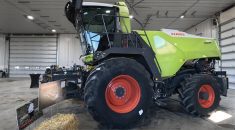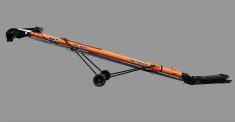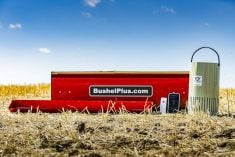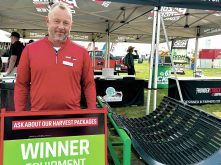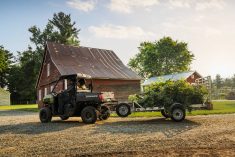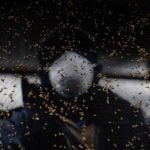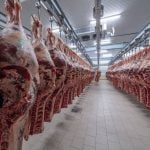When seeding fields beside the Trans-Canada Highway, the Nexat engineering team says traffic has often stopped as passersby try to figure out just what they’re looking at.
Fair enough, because the Nexat is like no other conventional field machine. It’s an implement carrier designed to handle every field operation from seeding to harvesting and work in a controlled traffic plan to minimize soil compaction.
Grainews spent a day in the field near Elie, Man., with the first Nexat to come to Canada. Elie will be the location for the company’s first Canadian sales and service hub, where the company expects to begin selling the Nexat in time for the 2026 season.
Read Also

Claas brings 1000 Series SP forage harvesters to Canada
In mid-August, Claas unveiled its new line of Jaguar forage harvesters at an event in Visalia, California, deep in the heart of that state’s dairy region.
The Nexat was planting soybeans as the machine begins its first full season of proving itself in a Canadian field, although a total of 18 prototypes are now already working in fields in Europe and South America. In all, field trials have been ongoing for about seven years.
“It’s the first spring for us in Canada,” Nexat’s founder and CEO Klemens Kalverkamp says. “We were seeding in the U.S. last year and since 2019 in Ukraine. So it’s the sixth year for planting and seeding.”
The Germany-based company builds the basic machine and has looked to specialist manufacturers to design and supply all the implements it uses to do field work, picking those companies whose implements Kalverkamp feels best suit agriculture on the continent where they’ll be used.
The exception to that is the combine attachment, which Nexat designed and built in-house.
“For the combine unit, there are no mid-size partners in ag tech,” Kalverkamp says. “In all the other products we are working together with mid-size innovative companies.”
Using those attachments designed by partner companies, the Nexat is able to completely replace a conventional tractor and combine. “The basic principle is you just need one machine to do all the jobs, seeding, planting, spraying, tillage and harvesting.”

Advantages
But Kalverkamp believes the Nexat does more than provide an alternative to traditional tractor and implement designs by offering advantages those machines can’t match.
By carrying the implement — and, in the case of the seed drill, the product tanks — draught and wheel slippage are reduced, improving fuel efficiency.
“We have less fuel consumption, less complexity,” Kalverkamp says. “At the end of the day it’s a simple machine, very service-friendly. Every service technician can change any part with a digital animation.”
The company provides that digital service information.
The simplicity comes from a dual-engine drive system, each powering an electrical generator that drives four electric motors on the track modules.
“All the (electric) motors are the same,” he says. “With modern tractors if you have a problem in the gearbox, it takes two days to fix it. To take out and replace an electrical motor is done in four hours. And it can be done by any average service technician.”
Each diesel engine is rated at 550 horsepower, but some operations, such as seeding or spraying, will only require running one of them. The combine attachment would need power from both, due to its higher demand for horsepower.
The current Nexat model uses two Leibherr diesels, which are popular in trucks and construction equipment in Europe. But the company expects to be able to offer North American buyers the option of replacing them with Cummins engines.
“We’re not just thinking about how we can make the tractor or combine better,” Kalverkamp says. “We’re thinking about how we can improve the whole process.”
Related: Check out the NEXAT All-in-One Crop Production System System Specifications
As he sees it, one of the biggest advantages the Nexat offers is its ability to allow farmers to improve soil conditions. Using a controlled traffic pattern with its tracks — or optional wheels — always following in the same path, roughly 95 per cent of the field surface remains untouched. That significantly reduces compaction problems.
“After 40 years of travelling around to farms all around the world, I recognized that there is one problem everywhere, and that is compaction. In the last five years I’ve thought a lot about the soil (and how to rejuvenate it).”

As the Nexat runs through the field, steering itself and guided by GPS, the cab can be pivoted to the rear. That allows the operator to observe the back of the machine and monitor implement operation from a perspective not available from a regular tractor cab.
Inside the cab, the sound level is remarkably low, because the engines are several feet away on the main body of the machine. The operator can move the cab through an arc of more than 180 degrees.
For roading, the tracks or wheels pivot 90 degrees, creating an overall travel width of just 12 feet — and it can hit a top speed of 40 km/h. To help back it into tight spaces, the Nexat can be controlled with a wireless remote control.
“It’s the first holistic, planned production system, we call it,” Kalverkamp says. “It’s not just a machine. It’s much more. With our technology we want to enable farmers to make more profit, have better soil condition with less erosion and putting C02 back into the ground. And we’ve proven we can do this.”

The K-Hart drill
Anyone whose been to a western Canadian farm show recently may have noticed the K-Hart Spyder seed drill on display. While arguably not yet a household name in the seeding sector compared to other brands, K-Hart is the partner chosen to supply the seed drill attachment for the Nexat in this country.
“In Canada we’re working together with K-Hart,” Kalverkamp says, “because K-Hart has openers with minimum soil disturbance at the surface. In a dry spring like this, it’s very important.”
The K-Hart drill design impressed Kalverkamp, who says he only wants to partner with shortlines that are innovative to develop attachments for the Nexat.
“We worked with Nexat to help bridge the gap between our current design and a design that fits on the Nexat unit,” says the director of engineering at K-Hart Industries, Erron Leafloor. “This is the second prototype. The first one ran in Europe last fall.”
The drill attaches to the Nexat with standard category 4 three-point hitch connections, for a straightforward attachment process.
“Probably most of the time is just hooking up air hoses,” Leafloor says. “At one single bank you have all the electrical and hydraulics connected.”
The K-Hart attachment uses the same double-disc opener found on the brand’s own Spyder drill.
“The core (opener) technology we use at K-Hart is through another partnership we have with Tony Gent out of the U.K.,” Leafloor says. “It’s a very unique concept of the double disc but at an angle so you don’t get sidewall compaction. That helps with root growth. The root can actually grow in both directions.”
Although the Nexat’s rigid frame spans the entire 45-foot working width of the drill, the openers get a total of nearly two feet of vertical travel to contour across irregular field surfaces.
“We have the openers on a traditional parallel link,” Leafloor says. “But on top of that, the entire frame is on a parallel link. With the smaller (frame) sections you can travel in and out of ditches. Each of these sections will travel an additional approximately 13 inches.
A front row of coulters delivers fertilizer in a mid-row banding style. It’s also possible to deliver a starter course into the trench with the seed.
Rather than pull an air cart, the product tanks ride above the drill, and the company expects to offer total comparable capacity to a conventional prairie drill setup to maintain seeding efficiency.
The product and seed storage bins and delivery system are provided by Vaderstad. The distribution system, meanwhile, is a K-Hart design.

Hitting the market
Kalverkamp says the company expects its initial sales will be to early adopters. A few of those have already contacted the company.
“We were looking for the best reference farmers,” he says. “A ‘reference farmer,’ in our way of thinking, is progressive, a first-mover. They’re using the latest technology to keep on the (cutting) edge of their business.
“Our business philosophy is long-term. We want to make customers happy. If they’re not, we’ll take back the machine.”
While the Nexat basically runs on its own at the moment, with little for the operator to do, the company expects to make the operator’s cab redundant within the next three years. It’s planning to introduce a fully autonomous version by 2028.
The Nexat was designed with full autonomy in mind right from the start, Kalverkamp says.
This November, at Agritechnica in Germany, the company will debut a 90-foot model, which may be available to Canadian buyers for next season.




